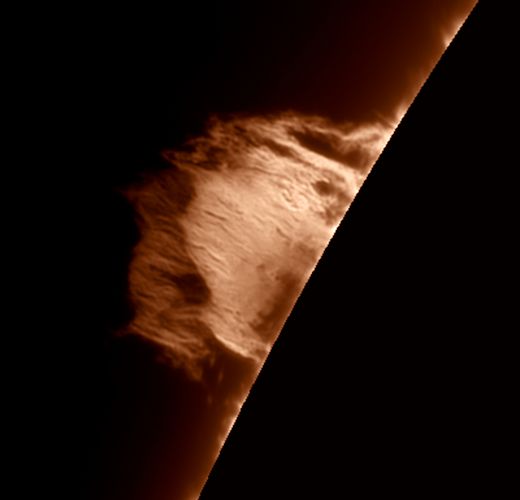From the Spaceweather's time machine at http://www.spaceweather.com/archive.php ... &year=2017
HEDGEROW PROMINENCE: On the northeastern edge of the sun, a wall of hot plasma has
sprung up, towering more than 40,000 km above the stellar surface. Randy Shivak photographed
the enormous structure from his backyard observatory in Estero, Florida:

"Even though the sun is blank (no sunspots) there are still some impressive things to see," says Shival. "I captured this prominence using my Astro-Physics 152mm refracting telescope and a Daystar Quantum PE 0.5 angstrom filter. It's a big one!"
This is a "hedgerow prominence" -- a massive cloud of plasma held aloft by solar magnetic fields. NASA and Japanese space telescopes have taken high resolution images of similar prominences and seen some amazing things such as (1) tadpole-shaped plumes that float up from the base of the prominence; (2) narrow streams of plasma that descend from the top like waterfalls; and (3) swirls and vortices that resemble van Gogh's Starry Night. Got a solar telescope? Take a look!
Ah, so this is most likely what I have been noticing around the northeastern perimeter of the sun.
According to Belgium, there are at least two (several) prominent filaments which could erupt into a hyderflare and unleash an earth-directed solar flare. Thus, even though we are in a solar minimum with no active regions on the solar disc, we still could get a geo-directed solar flare from these hedgerow prominences. Active regions are not the only source of M and X-flares.
From Belgium's Royal Observatory at http://www.sidc.be/products/meu/
COMMENT: The visible solar disc was spotless and no flares have been
recorded in past 24-hour. The solar activity is expected to remain quiet
with the X-ray flux below C level.
No Earth directed Coronal Mass Ejection have been observed. Several
filaments are visible on the disk, which prevent us to initiate the all
quiet alert as it cannot be excluded that one filament erupt with some
Earth-directed components.
The solar protons flux remained at background levels over the past 24 hours
and is expected to remain so.
The Earth is now in the slow flow of the solar wind that as globally
decreased from 530 km/s to the current value of 470 km/s. The declining
trend of the solar wind parameter is expected to continue until it reaches
about 350 km/s. The interplanetary magnetic field magnitude remained below
6 nT and the Bz component fluctuated between -4 and 4 nT. The solar wind
parameters are expected to remain at the nominal level for the next 3 days.
A narrow northern polar coronal hole extension down to latitude 10-degree
North was facing Earth yesterday afternoon on Nov 11. The associated high
speed stream is not expected to reach Earth before Nov 14.
As the fast solar wind has faded away, the geomagnetic conditions were
quiet (local K Dourbes 1-2, NOAA Kp 1-2) and are expected to remain quiet
until the high speed stream associated with the new coronal hole reaches
Earth in several days.
TODAY'S ESTIMATED ISN : 000, BASED ON 20 STATIONS.
For a more recent image from NASA, please visit:
https://www.thesuntoday.org/the-sun-now/
